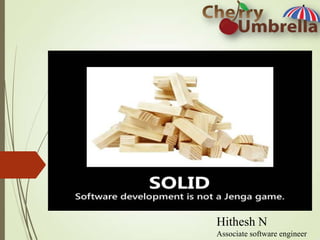
Solid Principles
- 1. Hithesh N Associate software engineer
- 2. Single Responsibility Principle Open/Closed Principle Liskov Substitution Principle Inter face Segregation Principle Dependency Inversion Principle
- 3. Code becomes more Testably (remember TDD is not only about testing, more important its about Design) Apply ’smart’ - don’t do stuff ’just because of’ - very importad to see the context of the program/code when applying SOLID - Joel On Software advise – use with common sense!
- 5. How can we tell when our code is rotting?
- 6. Rigidity Design is to hard change
- 7. Fragility Design is easy to break
- 8. Immobility Design is hard to reuse
- 9. Viscosity Design makes hard to do the right thing
- 11. Definition “Every object should have a single responsibility and that responsibility should be entirely encapsulated by the class” “Class should have one responsibility - one reason to change” My translation: A class should concentrate on doing one thing and one thing only
- 12. Example Two resposibilities interface Modem { public void dial(String pno); public void hangup(); public void send(char c); public char recv(); } Connection Management + Data Communication
- 13. Separate into two interfaces interface DataChannel { public void send(char c); public char recv(); } interface Connection { public void dial(String phn); public char hangup(); }
- 14. Argument Against SRP “To Many classes and too difficult to understand the BIG PICTURE” There are no more moving parts in a system with many small pieces than that with a few large pieces. The benefits outweigh this argument. Consistency, Good names and documentation make this a mute point.
- 15. What are some of the benefits Reuse - If all your class follow the SRP,you are more likely to reuse some of them Clarity - Your code is cleaner as your class don’t do unexpected things Naming –As all your classes have a single responsibility, choosing a good name easy Readability –Due to the clarity, better names and shorter files the readability is improved greatly Smaller Function -
- 17. A module should be open to Extensibility ,but closed for modification My translation: Change a class' behavior using inheritance and composition
- 18. Example // Open-Close Principle - Bad example class GraphicEditor { public void drawShape(Shape s) { if (s.m_type==1) drawRectangle(s); else if (s.m_type==2) drawCircle(s); } public void drawCircle(Circle r) {....} public void drawRectangle(Rectangle r) {....} } class Shape { int m_type; } class Rectangle extends Shape { Rectangle() { super.m_type=1; } } class Circle extends Shape { Circle() { super.m_type=2; } }
- 19. Open Closed Principle – a Few Problems… Impossible to add a new Shape without modifying GraphEditor Important to understand GraphEditor to add a new Shape Tight coupling between GraphEditor and Shape Difficult to test a specific Shape without involving GraphEditor If-Else-/Case should be avoided
- 20. Open Closed Principle - Improved // Open-Close Principle - Good example class GraphicEditor { public void drawShape(Shape s) { s.draw(); } } class Shape { abstract void draw(); } class Rectangle extends Shape { public void draw() { // draw the rectangle } }
- 21. Challenges with using OCP?
- 22. Challenges Expensive – Requires significant effort Experience – best judgment Research – ask the right question
- 24. Liskov Substitution Principle “Derived classes must be substitutable for their base class” My translation: Subclasses should behave nicely when used in place of their base class
- 25. Liskov Substitution Principle class Square extends Rectangle // Violation of Liskov's Substitution Principle { class Rectangle public void setWidth(int width){ { m_width = width; int m_width; m_height = width; int m_height; } public void setWidth(int width){ m_width = width; } public void setHeight(int h){ m_height = ht; } public int getWidth(){ return m_width; } public int getHeight(){ return m_height; } public int getArea(){ return m_width * m_height; } } public void setHeight(int height){ m_width = height; m_height = height; } }
- 26. Liskov Substitution Principle class LspTest { private static Rectangle getNewRectangle() { // it can be an object returned by some factory ... return new Square(); } public static void main (String args[]) { Rectangle r = LspTest.getNewRectangle(); r.setWidth(5); r.setHeight(10); // user knows that r it's a rectangle. It assumes that he's able to set the width and height as for the base class System.out.println(r.getArea()); // now he's surprised to see that the area is 100 instead of 50. } }
- 28. Interface Segregation Principle "Clients should not be forced to depend upon interfaces that they do not use.“ My translation: Keep interfaces small
- 29. Interface Segregation Principle //bad example (polluted interface) interface Worker { void work(); void eat(); } ManWorker implements Worker { void work() {…}; void eat() {30 min break;}; } RobotWorker implements Worker { void work() {…}; void eat() {//Not Appliciable for a RobotWorker};
- 30. Interface Segregation Principle Solution - split into two interfaces interface Workable { public void work(); } interface Feedable{ public void eat(); }
- 32. Dependency Inversion Principle A. High level modules should not depend upon low level modules. Both should depend upon abstractions. B. Abstractions should not depend upon details. Details should depend upon abstractions.“ My translation: Use lots of interfaces and abstractions
- 33. Dependency Inversion Principle //DIP - bad example public class EmployeeService { private EmployeeFinder emFinder //concrete class, not abstract. Can access a SQL DB for instance public Employee findEmployee(…) { emFinder.findEmployee(…) } }
- 34. Dependency Inversion Principle //DIP - fixed public class EmployeeService { private IEmployeeFinder emFinder //depends on an abstraction, no animplementation public Employee findEmployee(…) { emFinder.findEmployee(…) } } Now its possible to change the finder to be a XmlEmployeeFinder, DBEmployeeFinder, FlatFileEmployeeFinder, MockEmployeeFinder….